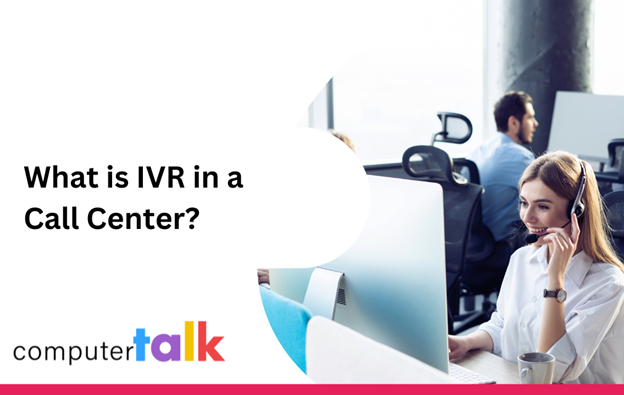What is IVR in a Call Center?
by Nicole Robinson | Published On January 15, 2024 | Last Updated January 17, 2024

Explore IVR's crucial role in modern call centers, optimizing customer interactions and operational efficiency with advanced technology.
Interactive Voice Response (IVR) systems; they're the friendly automated voices that guide you through a menu of options when you call a business for support.
IVRs are automated telephony systems that interact with callers, gather information, and route calls to appropriate recipients. IVR technology is more than just a convenience; it's a crucial part of today's customer service, enhancing both the customer experience and call center efficiency.
As the market for IVR continues to expand from $4.2 billion in 2020 to $6.7 billion by 2026, with a 7.9% compound annual growth rate, its role in facilitating smoother, more human-like interactions between customers and automated systems becomes ever more prominent. This technology can stream operations while ensuring that customers receive timely and effective assistance, making every call a step towards better service.
Starting with the Basics: What is IVR and How Does it Work?
IVR, commonly known as a phone tree, is an automated system designed to guide customers through service options using a voice menu. When a customer calls in, the IVR presents various options, each leading to different service paths, such as connecting with specific departments or addressing frequently asked questions.
This application is the first touchpoint between the customer and the call center, setting the tone for the service experience.
IVR technology extends beyond its basic functionality of automated call navigation and routing. Now, it incorporates advanced features like better voice recognition, intelligent algorithms for context-aware responses, and dynamic interactions, enabling personalized and efficient customer service experiences.
Integrating Natural Language Processing (NLP) and Artificial Intelligence (AI) with traditional telephony infrastructure has significantly enhanced IVR systems. They are now adept at efficiently interpreting and processing nuanced voice commands and Dual-tone Multi-frequency (DTMF) signaling.
The operational complexity of IVR systems lies in their ability to accurately decipher complex user inputs. With such advanced functionality, calls are intelligently routed to provide the most relevant information and assistance to the caller.
Understanding the Role of an IVR Number

An IVR number in a call center context is a designated phone line that connects callers to the IVR system. This number serves as the initial point of interaction for customers seeking support or information.
When a customer dials this number, the IVR system activates, guiding them through a series of options to address their specific needs.
Configuring an IVR number is a critical aspect of call center operations, ensuring efficient call routing and management. It's a key tool in the call center's arsenal, enabling quick, accurate navigation through the system and facilitating the effective handling of customer inquiries.
What Are the Benefits of IVR?
The advantages of modern IVRs in call centers are multifaceted, significantly benefiting both call centers and customers by extending beyond basic call routing:
1. Optimization of Call Volume Handling:
Sophisticated IVR systems efficiently distribute incoming calls based on the nature of the inquiry and available resources, effectively balancing the load across different departments or agents. This targeted management of calls ensures that high volumes are handled promptly, reducing wait times and streamlining the flow of customer inquiries.
2. Cost-Effectiveness and Resource Allocation:
By automating responses to routine inquiries, IVR systems allow more strategic allocation of human resources. McKinsey & Company's study underlines the financial impact, noting that improving IVR containment rates by a mere 5% can result in a 10% to 30% reduction in operational costs.
3. Enhancement of Customer Service Experience:
The provision of 24/7 automated services, coupled with personalized interaction capabilities, positions IVR as a critical tool in customer satisfaction and retention strategies.
4. Data-Driven Insights for Strategic Planning:
The analytics derived from IVR systems facilitate informed decision-making. IVR systems collect a wealth of data from every interaction, such as call duration, caller responses, and frequency of specific queries. This data is then analyzed using various methods, like pattern recognition and trend analysis, to gain insights into customer behavior and service efficiency. For example, if an IVR system reports a high frequency of calls regarding a specific issue, a call center can strategize to address this issue more effectively, either by updating the IVR script to provide better information or by training agents to handle these queries more efficiently, thereby improving overall service quality and customer satisfaction.
IVR Best Practices to Follow
Deploying IVR systems in a call center environment involves adherence to a set of refined best practices:
1. Intricate Menu Design and Architecture:
Develop IVR menus by carefully analyzing customer interactions and preferences to ensure they are both straightforward for callers to use and encompass all necessary service options.
2. Continuous Evolution and Adaptation:
Regularly updating IVR systems to incorporate the latest technological advancements and customer feedback ensures the system remains relevant and effective. A company can achieve continuous evolution and adaptation of its IVR systems by systematically gathering and analyzing customer feedback, monitoring call metrics for performance, and staying updated with emerging tech trends to periodically enhance and refine the system's features and functionalities.
3. Balance Between Automation and Human Interaction:
While customer service automation is key, maintaining the option for callers to engage with human agents is crucial for handling complex or sensitive issues.
Application Integration with IVR Software
IVR software app integrations can significantly contribute to enhancing the functionality of call center operations, with key integrations including:
- CRM for a Personalized Customer Journey: Integrating with Customer Relationship Management (CRM) platforms enriches IVR systems, allowing personalized customer interactions that are both data-informed and efficient. This enhances customer engagement by leveraging detailed customer data during calls, ensuring a more informed and streamlined experience.
- Analytics Integration for Performance Optimization: Linking IVR systems with analytics tools, like Microsoft PowerBI, offers vital insights into call patterns, agent performance, and customer satisfaction metrics. It is essential for monitoring and improving the overall efficiency and effectiveness of call center operations.
- Workforce Management (WFM) System Integration for Operational Efficiency: Aligning IVR systems with workforce management tools optimizes agent scheduling in accordance with call volume trends. This enhances operational efficiency by ensuring optimal staffing levels, thus reducing wait times and improving overall customer service quality.
Conclusion
IVR technology, particularly in its advanced implementations, is impactful in the modern call center's strategy to optimize operations and enhance customer experiences. As the customer experience management market is to expand significantly from $14.95 billion in 2022 to $52.54 billion by 2030, the role of sophisticated IVR systems becomes increasingly vital.
IT administrators and call center managers looking to stay ahead of the latest developments and best practices in IVR technology can explore more insights about IVR here.
More from our blog
 Happy Valentine’s Day! On this day of love, we often think about ways we can show love and appreciation to the important people in our lives. But while it may not be your first thought, today is also a great...
Happy Valentine’s Day! On this day of love, we often think about ways we can show love and appreciation to the important people in our lives. But while it may not be your first thought, today is also a great...
 In a world that's constantly evolving, so are we. We're kicking off the new year with a rebrand, and we're super excited to share what’s new!
In a world that's constantly evolving, so are we. We're kicking off the new year with a rebrand, and we're super excited to share what’s new!
 Utility companies make the world go around. They’re the organizations responsible for ensuring we all have access to energy, heat, water – everything we need to thrive. The utility contact center acts as the main bridge between these essential businesses...
Utility companies make the world go around. They’re the organizations responsible for ensuring we all have access to energy, heat, water – everything we need to thrive. The utility contact center acts as the main bridge between these essential businesses...

